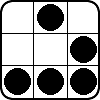A few things I noticed:
- It looks weird that the ball has BoundClose and BounceNear parameters. I'd let the ball move anywhere and check outside the Ball's Update method if it's a point for any of the players.
- It also looks weird that in the Ball's Update method you send both Paddles, it's like you put all the collision detection inside the Ball class. I'd take that out into something that checks for collisions, and add methods in Paddle and Ball classes to react to collisions.
- I can't find anything about timing, it looks like you update and draw everything as soon as you can. Implementing a way to limit the the frame rate is usually a must for games, so the game fells the same in any computer you play. You basically check how much time has passed since your last iteration of the gameloop, send that value into all the "Update" methods (and do everything considering that time) and wait some milliseconds before executing the next iteration. Later you can add fixed updates for physics too.
- Speaking about Update methods, if you send the same thing every time consider setting those things as attributes once instead. It's also uncommon that your WorldObject doesn't have an Update method and the derived classes have different Update methods. It's not bad, but in almost every engine and game I worked in the base game object has an Update(float deltaTime) method. This also makes it easier to update the game objects in games that the object count is dynamic. Now you have the paddles and the ball and update each one in a line, but imagine a Breakout game, where you also have a different number of blocks in each level.
- In WorldObject you have some empty constructors, is that OK?
- The "Movable" class has a name that sounds like an Interface, but it has some code. Couldn't that code be part of WorldObject? Or some WorldObjects don't move? I only see that Paddle and Ball are.








